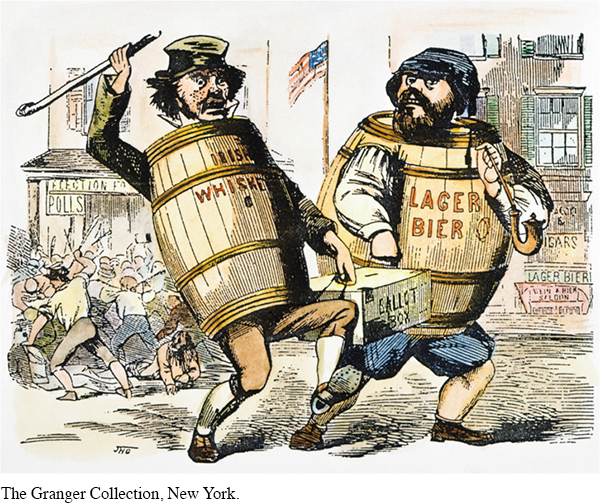The New Parties: Know-Nothings and Republicans
Dozens of new political organizations vied for voters’ attention. Out of the confusion, two emerged as true contenders. One grew out of the slavery controversy, a coalition of indignant antislavery Northerners. The other arose from an entirely different split in American society, between native Protestants and Roman Catholic immigrants.
The wave of immigrants that arrived in America from 1845 to 1855 produced a nasty backlash among Protestant Americans, who feared that the Republic was about to drown in a sea of Roman Catholics from Ireland and Germany (see Figure 12.1, “Immigrants and the Free-Labor Ladder” in chapter 12) Nativists (individuals who were anti-immigrant) began to organize, first into secret fraternal societies and then in 1854 into a political party. Recruits swore never to vote for either foreign-born or Roman Catholic candidates and not to reveal any information about the organization. When questioned, they said, “I know nothing.” Officially, they were the American Party, but most Americans called them Know-Nothings. [[LP Photo: P14.04 Know-Nothing Cartoon – VISUAL ACTIVITY/

The Know-Nothings enjoyed dazzling success in 1854 and 1855. They captured state legislatures throughout the nation and claimed dozens of seats in Congress. Democrats and Whigs described the Know-Nothings’ phenomenal record as a “tornado,” a “hurricane,” and “a freak of political insanity.” But by 1855, an observer might reasonably have concluded that the Know-Nothings had emerged as the successor to the Whigs.
The Know-Nothings were not the only new party making noise, however. One of the new antislavery organizations provoked by the Kansas-Nebraska Act called itself the Republican Party. The Republicans attempted to unite all those who opposed the extension of slavery into any territory of the United States.
The Republican creed tapped into the basic beliefs and values of Northerners. Slavery, Republicans believed, degraded the dignity of white labor by associating work with blacks and servility. As evidence, they pointed to the South, where, one Republican claimed, nonslaveholding whites “retire to the outskirts of civilization, where they live a semi-savage life, sinking deeper and more hopelessly into barbarism with every succeeding generation.” Republicans warned that the insatiable slaveholders of the South, whom antislavery Northerners called the “Slave Power,” were conspiring through their control of the Democratic Party to expand slavery, subvert liberty, and undermine the Constitution.
Only by restricting slavery to the South, Republicans believed, could free labor flourish elsewhere. In the North, one Republican declared in 1854, “every man holds his fortune in his own right arm; and his position in society, in life, is to be tested by his own individual character.” Without slavery, western territories would provide vast economic opportunity for free men. Powerful images of liberty and opportunity attracted a wide range of Northerners to the Republican cause.
> COMPARE AND CONTRAST
What were the primary goals of the Republican Party and the Know-Nothing Party? What did they have in common, and how did they differ?
Women as well as men rushed to the new Republican Party. Indeed, three women helped found the party in Ripon, Wisconsin, in 1854. Although they could not vote and suffered from other legal handicaps, women nevertheless participated in partisan politics by writing campaign literature, marching in parades, giving speeches, and lobbying voters. Women’s antislavery fervor attracted them to the Republican Party, and participation in party politics in turn nurtured the woman’s rights movement. Susan B. Anthony, who attended Republican meetings throughout the 1850s, found that her political activity made her disfranchisement all the more galling. She and other women in the North worked on behalf of antislavery and woman suffrage and the right of married women to control their own property.
Understanding the American Promise 3ePrinted Page 386
Section Chronology